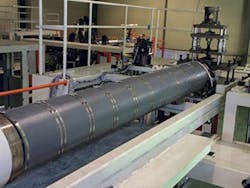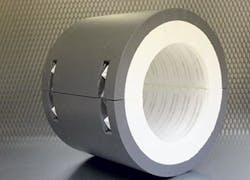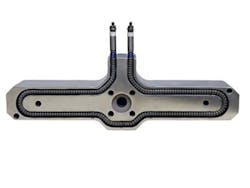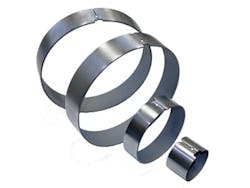Temperature Control: Latest products manage the transfer of heat
Working with heat is a tricky endeavor because, like water, heat always seeks equilibrium. It continuously moves from warmer areas to cooler ones until everything is the same temperature, and that presents a doubly thorny problem for plastics processors.
When heat escapes the area where it's needed, it wastes energy and increases costs. It also drives up temperatures on the shop floor, making the work environment uncomfortably hot.
Equipment manufacturers are continuously working to attack the problem from both angles: making the transfer of heat to the place it's needed more efficient, and keeping that heat from escaping to places where it isn't wanted.
REX MATERIALS
The Thermal Control Solution (TCS) from Rex Materials Group consists of radiant heating elements that are embedded in high-temperature insulation. Designed to replace traditional band heaters, TCS can reduce barrel-heating costs by 40 percent and pay for itself in as little as 12 to 24 months, depending on the amount of energy consumption and cost of electricity, the company said.
TCS, which can be used on injection molding, blow molding and extrusion machinery, was first introduced in 2006, but Rex has improved its design regularly and consistently. The company's most recent upgrade was replacing the product's Teflon covers with a two-part, high-temperature coating, which results in easier installation and greater durability.
The system also keeps the melt at a more consistent temperature than traditional band heaters, which cycle on and off. When the melt drops below the set temperature, band heaters turn on and provide heat until the temperature is regained — but even after shutting off, their residual heat pushes the temperature a little higher than the set point. The heaters turn back on when the melt cools, but by the time the heat kicks in, the melt temperature is slightly below the set point. TCS, on the other hand, keeps the temperature more consistent by using radiant heat transfer, which delivers heat via infrared radiation and greatly reduces the amount of heat that escapes.
An increasingly important selling point for TCS is its ability to provide a more comfortable work area. A major drawback of band heaters is that much of the heat they generate is lost to the surrounding environment rather than delivered directly to the melt.
"This causes two enormous problems for shop owners," said Ken Van Nimwegen, global sales manager with Rex. "First, that overheated air is miserable for the people working in it, so the company is either going to suffer higher turnover or have to pay more to keep people working there.
"Second, the shop is going to pay a lot more for energy. The usual solution for a hot shop floor is putting big fans on the ceiling, but all that does is push the hot air down and circulate it around the shop floor. Equally bad, the fans blow heat off the tops of the band heaters, causing them to burn more energy to maintain the necessary temperature. It's one of those circumstances where the 'solution' to a problem actually results in more and bigger problems," he said.
Other benefits of the product include:
• The barrel reaches its operating temperature in less than half the time of a standard band heater, increasing the machine's productivity.• The TCS is cool to the touch, so it poses no risk of burns or other injuries to workers.• There is little to no risk because the user doesn't need to make any modifications to the machine or its controls.
Rex also offers an optional cooling feature that uses specially designed blowers — encased in a durable, protective, sound-absorbing housing — to reduce the duration of the cool-down period when material changes or maintenance are required.
They can direct the hot air out of a temperature-controlled environment like a clean room, easing the load on the air conditioner and further reducing power consumption.
NEXTHERMAL
The designers and engineers at Nexthermal have been busy over the last year, upgrading and expanding an existing product line and introducing a new product for injection molders.
The first addition is the new and improved version of the company's Nextflex flexible tubular heater, as well as a new size in the series. The heaters now feature a radial tube casing that increases their flexibility and makes it possible to install them manually, without the need for bending tools.
Nextflex was designed to be used in packaging applications wherever formed tubular heaters are used, as well as in injection molding manifolds, and can be installed in just a few minutes using nothing more than a nylon hammer and a staking tool.
The new 6.5mm size supplements the existing 8mm and 8.5mm sizes. The smaller diameter size was added for use with thinner manifolds that require less wattage, where the radial bends are tighter and the plate thickness cannot accommodate an 8mm tubular heater.
Another benefit is that Nextflex can be shipped in straight lengths the same day it is ordered. Formed tubular heaters, on the other hand, need to be bent by the manufacturer to fit the unique manifold profile and often require six to eight weeks for delivery, Nexthermal said.
The company also has introduced a new product specifically for injection molders. The Constrictor thermal retainer is a band of metal that maximizes thermal transfer from the coil heater to the nozzle on an injection molding machine.
It is made of a special, proprietary alloy that has a different expansion rate than stainless steel. When the coil heater begins to expand, the Constrictor holds it tight, causing it to coil more tightly around the nozzle to maintain a high thermal-transfer rate.
"When the engineering services staff examined issues relating to diminished thermal transfer on injection molding nozzles, we found that as the coil heaters came up to temperature, the stainless steel they're made of expanded slightly. This caused them to lift off the nozzles and introduce a thin, insulative layer of air between the heater/thermocouple and the nozzle. The result negatively impacted the machine's performance," said Jeff Wheeler, Nexthermal's R&D manager. "The Constrictor prevents this from happening by forcing the heater to coil more tightly about the nozzle, optimizing thermal transfer."
He added that when there is inefficient heat transfer in the nozzle, it can lead to clogging, increased scrap and burned plastic, among other issues.
UNITHERM
Being a custom injection molder is, in one sense, like being extremely tall: If you need a new jacket, you will probably need to pay to have it custom-made, because what's available on store shelves won't meet your needs.
Tall people, unfortunately, will have to continue using tailors for their clothes, but UniTherm International has come up with a heating solution that works for all injection molders, but is especially valuable to those in the custom sector.
"What makes custom molders different is that they tend to make a lot of material changes throughout the day, and that means a lot of cool-down periods,"
UniTherm President Danny Sherrill said. That's the pain point for custom molders, because the same property that makes insulation so valuable — its ability to retain heat — also dramatically lengthens the amount of time the machine needs to cool down.
That's where QuickCool comes in. It's a custom insulation blanket designed to be installed over barrels and heater bands just like any other type of insulation and offers similar benefits, helping to retain the heat and reducing energy consumption by as much as 60 percent. What makes the QuickCool different from its competitors — as its name suggests — is that molders don't need to remove it to cool down their machines.
That's because the top half of the blanket has Velcro straps so all the operator has to do when it's time for a cool-down is open the flap and let the heat escape. The QuickCool blanket does not need to be removed from the barrel, which maximizes the machine's uptime, increases productivity and reduces labor costs.
The design of the Velcro attachment system was improved earlier this year to make it even easier and faster to attach or remove the blanket.
"Just like any other injection molder, custom molders benefit from having insulation on their barrels, in terms of heat retention and lower energy bills," Sherrill said. "But having to completely remove the insulation every time they need a cool-down takes a lot of time, and those delays add up when you have to make a lot of material changes and run at different temperatures."
Michael T. McCue, copy editor
For more information
Nexthermal Corp.,Battle Creek, Mich., 269-964-0271, www.nexthermal.com
Rex Materials Group,Howell, Mich., 517-223-3787, www.rexmaterials.com
UniTherm International Inc.,Lewisville, Texas, 972-436-1401, www.unitherm.com





